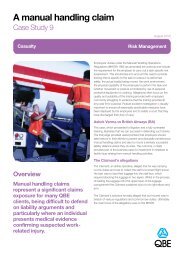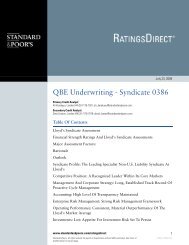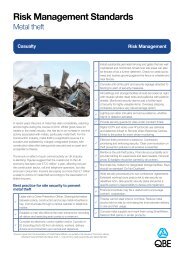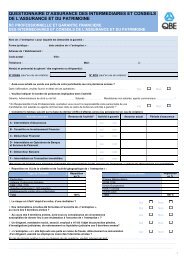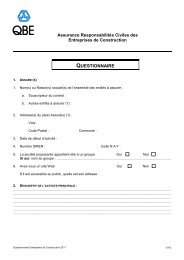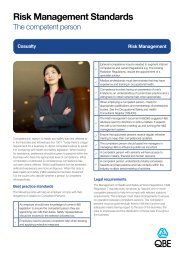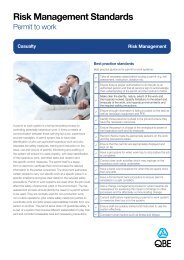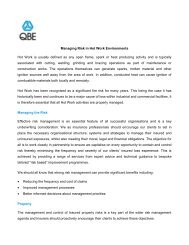QBE Syndicate 2999 Annual Report and Accounts 2009
QBE Syndicate 2999 Annual Report and Accounts 2009
QBE Syndicate 2999 Annual Report and Accounts 2009
Create successful ePaper yourself
Turn your PDF publications into a flip-book with our unique Google optimized e-Paper software.
Risk management<br />
The syndicate’s activities expose the business to a number of key risks which have the potential to affect the syndicate’s ability to achieve its business<br />
objectives. The board, supported by the risk <strong>and</strong> capital committee, is responsible for ensuring that an appropriate structure for managing these risks<br />
is maintained. The board’s appetite reflects the fact that it is not realistic or desirable to eliminate risk entirely, <strong>and</strong> therefore seeks to ensure that the<br />
appropriate controls are in place to effectively manage risks in line with the agreed tolerance.<br />
The syndicate continues to develop its risk management capability to ensure that an effective framework exists to support the management of all types<br />
of risk both currently <strong>and</strong> in the future under the Solvency II regime. Elements of this framework include the regular identification <strong>and</strong> assessment of the<br />
key risks <strong>and</strong> controls as well as clearly defined ownership of both the risks <strong>and</strong> controls.<br />
Risk groups<br />
The key risks can be grouped under the following headings:<br />
Insurance risk<br />
Credit risk<br />
Capital <strong>and</strong> liquidity risk<br />
Market risk<br />
Operational risk<br />
The syndicate’s business is to accept insurance risk, which is appropriate to enable it to meet its<br />
objectives. In line with the <strong>QBE</strong> Group risk strategy, the syndicate seeks to balance insurance risk<br />
with reward. All underwriting divisions are set specific <strong>and</strong> measurable performance targets, which<br />
they are expected to achieve by operating within the parameters of the approved business plan.<br />
In addition to the insurance terms of trade offered as st<strong>and</strong>ard, a certain amount of credit risk is<br />
unavoidable, as it can arise as a result of the inability or slow payment of any of the syndicate’s<br />
counterparties. The syndicate therefore seeks to limit exposure as far as is practical <strong>and</strong> has<br />
established detailed guidelines, procedures, limits <strong>and</strong> monitoring requirements to mitigate credit risk.<br />
The objective of the syndicate’s capital <strong>and</strong> liquidity risk management is to ensure that; capital is<br />
optimally managed; that the syndicate remains solvent by a significant margin <strong>and</strong> all withdrawals<br />
<strong>and</strong> funding requirements can be met out of readily available sources of funding. The syndicate<br />
seeks to maintain a strong liquidity position by holding its assets predominantly in liquid funds.<br />
Exposure to market risk is managed through the investment strategy, which reflects the appetite of<br />
the board. The strategy is deliberately conservative in order to eliminate potential volatility to market<br />
fluctuations as much as possible.<br />
The syndicate seeks to mitigate exposure to operational risks through ensuring that an effective<br />
infrastructure, robust systems <strong>and</strong> controls <strong>and</strong> appropriately experienced <strong>and</strong> qualified individuals<br />
are in place throughout the organisation.<br />
Group risk The syndicate seeks to align objectives to <strong>QBE</strong> Group strategy as well as to relevant Group policies,<br />
guidelines <strong>and</strong> reporting requirements. The CEO monitors <strong>and</strong> manages Group risks with the other<br />
Divisional CEOs within the Group through the Group Operations Executive.<br />
21<br />
<strong>QBE</strong> <strong>Syndicate</strong> <strong>2999</strong><br />
<strong>Annual</strong> report <strong>2009</strong>



